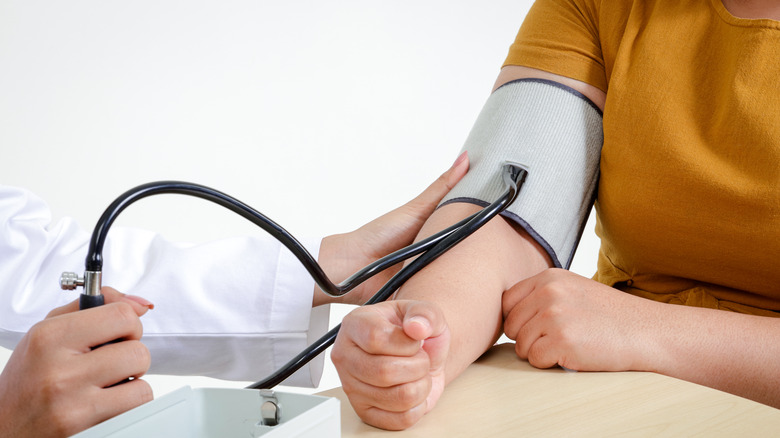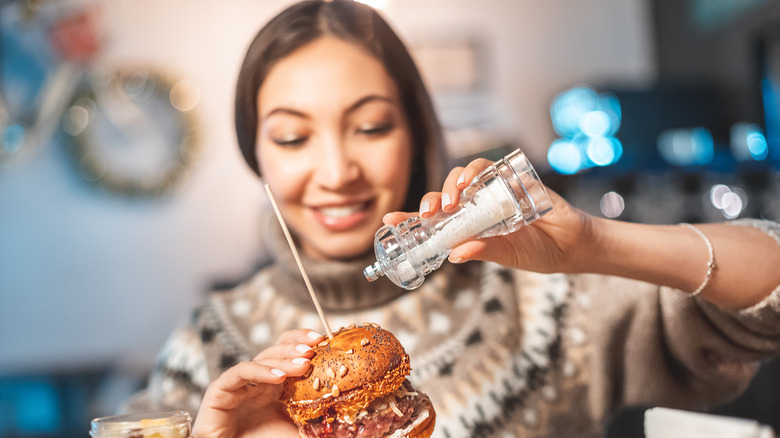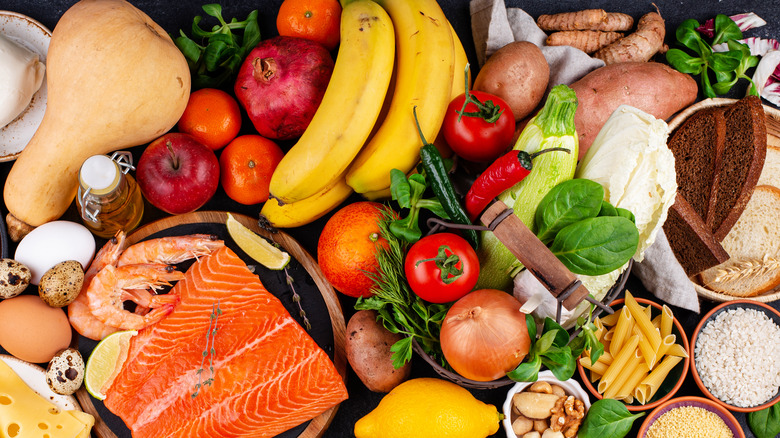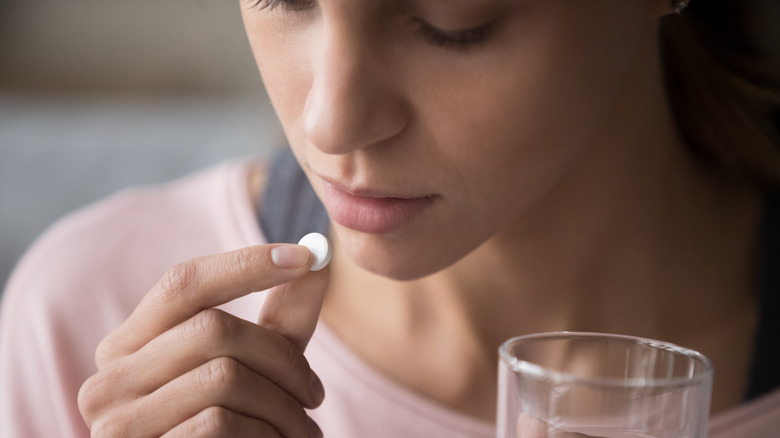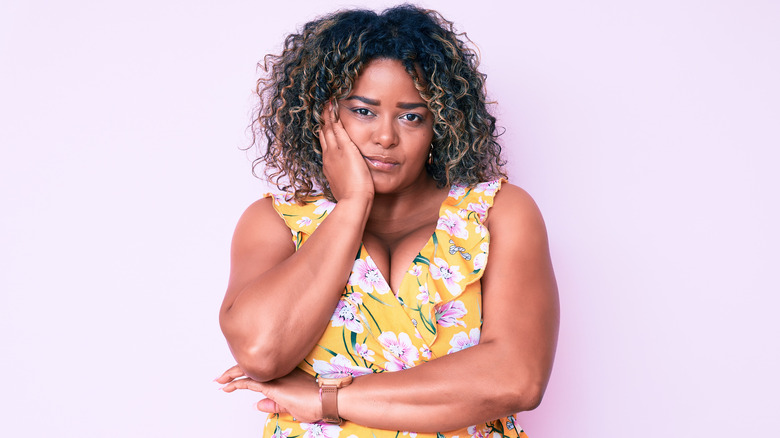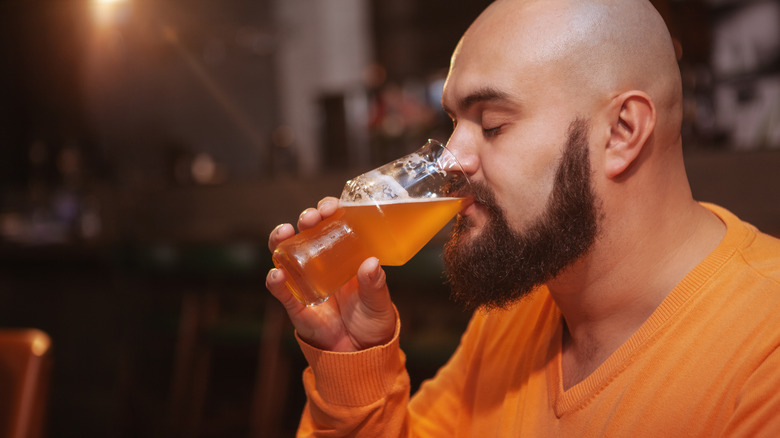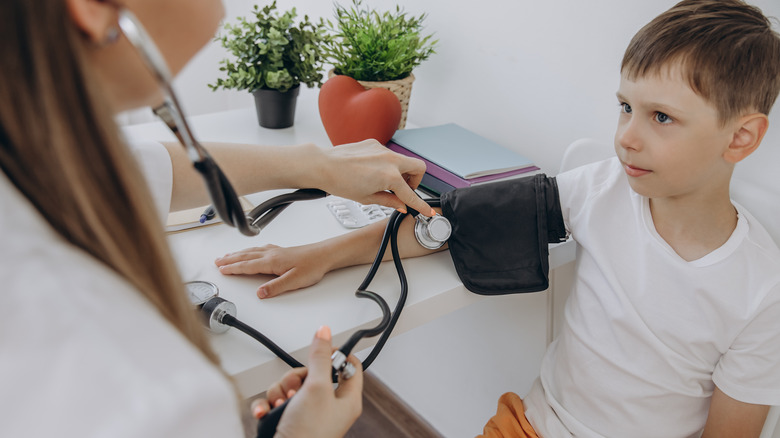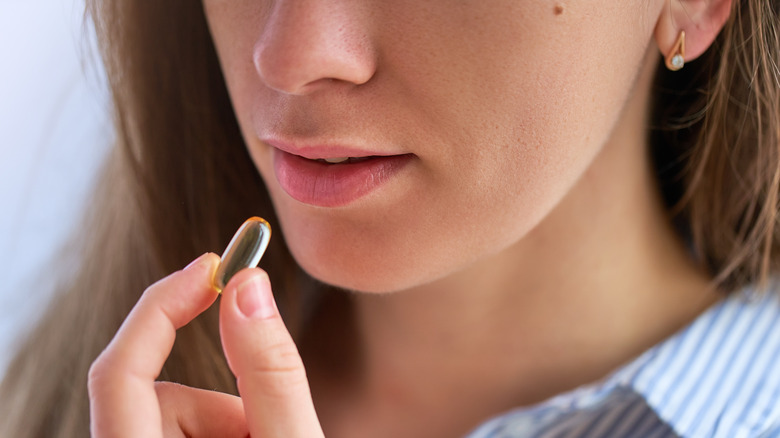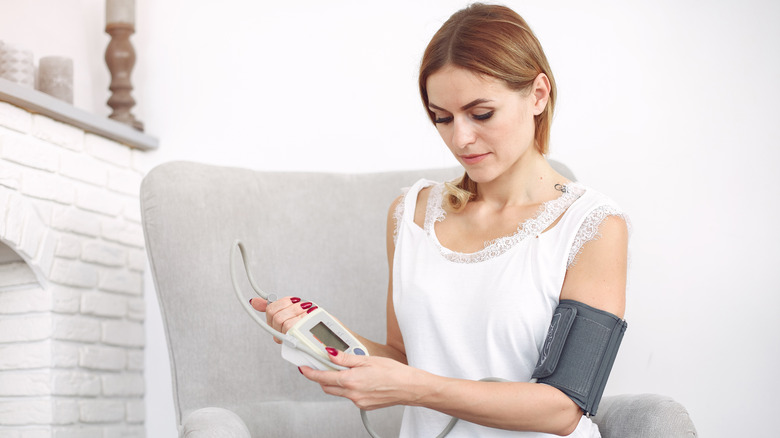High Blood Pressure Explained: Causes, Symptoms, And Treatments
You almost certainly know someone with high blood pressure, known as hypertension. It is an extremely common condition caused by the forceful pressure of the blood against the artery walls at higher than normal levels (via Mayo Clinic). "Blood pressure is determined both by the amount of blood your heart pumps and the amount of resistance to blood flow in your arteries," according to the Mayo Clinic. The narrower your arteries are, the higher your blood pressure is because the blood meets resistance when traveling through the arteries.
A doctor or nurse will typically tell you two numbers, like "120 over 80," when you get your blood pressure taken. The first number, 120 in this case, is called systolic pressure. It's a measure of the pressure in your arteries when your heart beats. The second number, 80 in this example, is called diastolic pressure and it measures the pressure in your arteries between beats. Blood pressure is measured in millimeters of mercury (mm Hg) — a throwback to the days when mercury was used in the first blood pressure cuffs ever developed (via the American Heart Association).
Most people aren't aware they have hypertension
According to WebMD, about one in three people who have high blood pressure aren't aware of it. Hypertension can be symptomless until it becomes severe. The symptoms that certainly warrant further investigation include severe headaches, nosebleeds, irregular heartbeat, blood in the urine, and pounding in the chest, neck, or ears.
The American Academy of Family Physicians explains that even when people have symptoms, they are often nonspecific and mimic other conditions. Because most people don't have any indication that there is a problem, it's important to get your blood pressure checked regularly. Adults aged 18 to 39 should have their blood pressure checked at least once every other year. However, if you know that you have high blood pressure, you'll need to get it checked more often. Additionally, adults 40 and over should have their blood pressure checked at least annually. "As you get older, you're more likely to suffer from high blood pressure," LaSante Health Center explained.
Primary and secondary hypertension
Most people with high blood pressure have primary hypertension, which means that no cause can be determined (via Mayo Clinic). The American Academy of Family Physicians explains that primary hypertension is also known as essential hypertension and probably develops from a combination of lifestyle and environmental factors as well as the aging process.
Secondary hypertension, on the other hand, has a cause that can be pinned down. According to the Mayo Clinic, causes include obstructive sleep apnea, kidney disease, adrenal gland tumors, thyroid problems, certain prescribed and over-the-counter medications, and the use of illicit drugs, such as cocaine. Secondary hypertension only occurs in 5 to 10% of the population and can be expensive to diagnose, often delaying the process while other possibilities are ruled out (via Cleveland Clinic). Possible symptoms or signs of conditions that can cause secondary hypertension, including changes in your weight, swelling, abnormal hair growth, and stretch marks on the abdomen.
Almost everyone has risk factors
There are several risk factors for hypertension that you have no control over. According to the CDC, everyone's risk increases as they age, and a whopping nine out of ten Americans will develop high blood pressure at some point during their lifetime. The American Heart Association (AHA) further expounds on this, saying that until age 64, men are more likely to get high blood pressure and, after age 65, women are more likely. In addition, race may also play a factor, as African Americans are more at risk for hypertension.
If your parents or other immediate family members have high blood pressure, there's an increased chance that you'll have it, too. The AHA explains that chronic kidney disease and hypertension have a close relationship, with each increasing the risk for the other. UCSF Health lists the top risk factors for high blood pressure which include a diet high in sodium and low in potassium and vitamin D, a sedentary lifestyle, drinking too much alcohol, a high-stress life, use of non-steroidal anti-inflammatory drugs (such as Advil, Motrin, or Ibuprofen) or certain cough and cold medications (those containing pseudoephedrine and phenylephrine), and specific chronic conditions including diabetes, kidney disease, and sleep apnea.
Complications
The alarming reality, as described by the Mayo Clinic, is that uncontrolled hypertension can be fatal. Probably the most well-known risk is for heart attack or stroke, which is brought about by atherosclerosis (hardening and thickening of the arteries) as a result of high blood pressure.
Hypertension can cause blood vessels to weaken and bulge; this is known as an aneurysm. If an aneurysm ruptures, it can be fatal. When blood pressure is high, the heart has to work harder to pump blood, which can cause the walls of the left ventricle to thicken. Over time, this can cause heart failure. Damage to blood vessels and arteries brought about by high blood pressure can occur in the kidneys, the eyes, and the brain, resulting in kidney disease, vision loss, and dementia.
Healthgrades notes that the plaque that builds up in the arteries lessens blood flow in the legs, resulting in pain, cramping, numbness, or heaviness in the lower extremities and buttocks. This is known as peripheral artery disease and can lead to gangrene and amputation in severe cases. The World Health Organization adds that hypertension can also cause chest pain, called angina, and an irregular heart rhythm, which sometimes results in sudden death.
Diagnosis is easy
The American Heart Association (AHA) has five blood pressure categories used for diagnosis and staging of hypertension. Normal blood pressure is less than 120/80 mm Hg. Elevated blood pressure falls between 120 to 129 mm Hg systolic and less than 80 mm Hg diastolic. If your reading falls into the elevated category, you should start to take steps to bring it down to avoid developing high blood pressure.
Hypertension Stage 1 is met when blood pressure is consistently between 130 to 139 mm Hg systolic and 80 to 89 mm Hg diastolic. If you have Hypertension Stage 1, your doctor might refer you to a registered dietitian and suggest other lifestyle changes. If you have other risk factors for heart disease, you may be put on medication at this stage.
Hypertension Stage 2 is diagnosed if your blood pressure is 140/90 mm Hg or higher. At this point, you will almost certainly require medication. If your blood pressure exceeds 180/120 mm Hg, the AHA recommends waiting five minutes and taking it again. If it's that high a second time, call your doctor immediately, as you might be experiencing what is known as a hypertensive crisis. If you are also experiencing chest or back pain, trouble breathing, numbness or weakness, a change in vision, or difficulty speaking, call 911.
Diet makes a big difference
The DASH diet is the best diet for people with hypertension. The diet is rich in whole grains, fruits, vegetables, and dairy. Lean meats, poultry, and fish are limited to two or fewer servings a day, and sweets are very strictly limited to five serving per week — but this doesn't mean five slices of cake! A serving is defined as a tablespoon of sugar or jelly, for example (via U.S. Department of Health and Human Services).
U.S. News & World Report, which ranked the DASH diet at 4.1 out of 5, added that the plan is rich in calcium, potassium, protein, and fiber while staying away from foods high in saturated fat and sugar. Sodium is limited to 2,300 milligrams a day to start, further decreasing to 1,500 milligrams over time. The site asserted that exercise is recommended on the DASH diet, especially if you want to lose weight, but it can be as simple as a 15-minute jaunt around the block each day.
In the ENCORE ("Exercise and Nutrition interventions for CardiOvasculaR hEalth") study completed between 2003 and 2008, participants were divided into three groups: the DASH diet alone, the DASH diet combined with a behavioral weight management program, or the usual diet control group for four months. The DASH plus weight management group experienced a blood pressure reduction of 16.1/9.9 mm Hg while the stand-alone DASH dieters' blood pressure went down by 11.2/7.5 mm Hg.
Medications for hypertension
There are many classes of medication used in the treatment of hypertension, as outlined by Healthline. Diuretics work by helping the kidneys excrete excess water and salt from the body, reducing the volume of blood that needs to pass through the vessels. Aldosterone-receptor antagonists also reduce the amount of fluid that the body retains. Beta-blockers block the actions of chemicals in your body that stimulate your heart; this slows down your pulse and causes your heart to pump less blood with each beat.
Angiotensin II is a hormone that narrows blood vessels, making it more difficult for blood to pass through the vessels and raising blood pressure. Angiotensin-converting enzyme (ACE) inhibitors block this hormone's effects, thereby bringing down blood pressure. Similarly, angiotensin II receptor blockers (ARBs) stop angiotensin II from binding to receptor sites necessary for it to affect the body. Calcium channel blockers block the calcium from entering the heart, causing the heart to beat with less force and encouraging relaxation of the blood vessels. Several classes of blood pressure medications block the release or binding of hormones that cause blood vessels to narrow and speed up heart rate, thereby increasing blood pressure. Additionally, vasodilators relax and widen blood vessels, easing the way for blood to flow with less force.
According to MedlinePlus, common side effects from high blood pressure medications include cough, gastrointestinal symptoms, dizziness or lightheadedness, sexual dysfunction, feeling nervous, headache, skin rash, weight changes, and tiredness.
Stress is the enemy of a healthy heart
When we are stressed, our bodies release hormones, including adrenaline, triggering the fight-or-flight response that we all remember from health class. This response causes our heart to beat faster and harder and our blood vessels to narrow (via Geisinger). Eventually, if this continues to happen to us, we will end up with high blood pressure.
In a 2021 app-based, three-week study using more than 300,000 responses per day from over 20,000 people, researchers confirmed that the more pressure people felt to accomplish things and the less help and assistance they perceived themselves as receiving (the more hopeless or helpless participants felt), the more blood pressure reactivity occurred. Furthermore, older adults demonstrated a stronger relationship between self-reported stress and blood pressure increases than did younger adults. Not surprisingly, blood pressure increased with negative emotions, such as anger, and decreased with low-arousal positive emotions, such as contentment.
Dr. Glenn Levine, a professor of medicine at Baylor College of Medicine, conducted a similar study and explained the interesting results in a statement, writing, "Stress, depression frustration, anger, and a negative outlook on life not only make us unhappy people but negatively impact our health and longevity" (via CNN). The study followed 412 multiracial adults between the ages of 48 and 87 with normal blood pressure. The researchers measured the levels of stress hormones in their urine numerous times over 13 years. They determined that a doubling of cortisol, a stress hormone released during periods of acute stress and danger, was associated with a 90% higher risk of having a cardiovascular event. Every time cortisol and the stress hormones norepinephrine, epinephrine, and dopamine increased, the risk of developing high blood pressure rose significantly.
Unhealthy behaviors can impact blood pressure
GoodRx makes the valid point that stress contributes to high blood pressure in another way — by increasing the likelihood that someone will develop unhealthy lifestyle behaviors, including smoking or vaping, making unhealthy eating choices, drinking too much alcohol or caffeine, not exercising enough, not taking medication as prescribed, and not getting enough sleep.
Both smoking and secondhand smoke increase the risk for plaque buildup inside the arteries and that this process is accelerated by high blood pressure, according to the American Heart Association. Every time that you light up, blood pressure increases. Heavy drinking seems to raise blood pressure by 5 to 10 mmHg and increases systolic pressure more than diastolic (via MedicineNet).
According to Johns Hopkins Medicine, some, but not all, people are sensitive to caffeine as it relates to their blood pressure. The best method to see if it's a problem for you is to take your pressure before and after drinking a cup. If your pressure increased by 5 to 10 mm Hg within 30 minutes of your cup, that's a sign to start cutting back. Remember that caffeine is also found in tea, chocolate, soda, energy drinks, dietary supplements, and some medications, including Excedrin. Additionally, when we sleep, our blood pressure drops, so if we don't sleep enough, it'll stay higher for a longer period (via the CDC).
During pregnancy, high blood pressure can be an emergency
As revealed by the American College of Obstetricians and Gynecologists, blood pressure can rise too high in some pregnant women, stressing the heart and kidneys. This high blood pressure might reduce blood flow to the placenta and increases the risks of preterm birth and cesarean birth, among other things.
Preeclampsia sometimes occurs in pregnant women with very high blood pressure, usually developing after 20 weeks of pregnancy. Preeclampsia can lead to a condition that causes seizures and strokes, known as HELLP syndrome, which stands for hemolysis, elevated liver enzymes, and low platelet count. HELLP syndrome results in damaged or destroyed red blood cells, which causes a decreased ability for the body to clot blood. Other repercussions include stomach pain, chest pain, and bleeding from the liver. Sadly, HELLP syndrome can be fatal.
The March of Dimes gets across the seriousness of high blood pressure among expectant mothers, citing gestational diabetes, heart attacks, kidney failure, pulmonary edema (fluid in the lungs), separation of the placenta from the uterus wall known as placental abruption, postpartum hemorrhage (PPH), and strokes as possible risks incurred by women with hypertension while pregnant.
Children can have high blood pressure too
According to the American Academy of Pediatrics (AAP), 3.5% of children and teenagers in the U.S. have hypertension. When left untreated, this can lead to organ damage and other health problems, including coronary artery disease as they get older.
Children should be screened for high blood pressure annually, starting when they turn 3 years old. Children and teens who have a family history of high blood pressure or heart disease or who have a mother who smoked during pregnancy are at a higher risk of developing hypertension, according to Cedars Sinai. Additionally, boys are more likely the girls to be affected.
By the age of 7, more than half of all cases of hypertension can be directly attributed to obesity (via AAP). In teenagers, nearly all cases (85 to 95%) are directly related to excessive body weight. Occasionally, high blood pressure in children indicates another serious health condition, such as kidney disease or an issue with the endocrine or nervous system.
The same lifestyle changes recommended to turn things around for adults also work for children with high blood pressure — limiting salt and fat intake and working more physical activity into the day. And just like with adults, if these strategies fail, prescription medication might be necessary. However, the AAP reveals that only 1% of children end up requiring medication.
Dietary supplements can help
Today's Dietitian explained that coenzyme Q10, flavonoids, soy protein, omega-3 fatty acids, vitamin D, calcium, magnesium, and potassium are your best bets for lowering blood pressure naturally. Coenzyme Q10 supplements are believed to work because of their antioxidant properties. This is also why flavonoids from cocoa (also found naturally in tea, wine, and grapes) appear to lower systolic blood pressure.
Taking 40 grams of soy protein per day of soy appears to decrease systolic blood pressure by 7.8 mm Hg. And as far as omega-3 fatty acids (think: fish oil supplements) are concerned, the Cleveland Heart Lab translated a meta-analysis published in the American Journal of Hypertension that showed that they can be as effective as other lifestyle changes for lowering blood pressure.
Although vitamin D doesn't appear to lower diastolic blood pressure, it does seem to have a slight lowering effect on systolic pressure, according to Today's Dietitian. Furthermore, Elizabeth Somer, registered dietitian, told the site, "Because [calcium, magnesium, and potassium] are also electrolytes that work with sodium in fluid balance, it makes sense to boost intake of these and lower sodium to treat and manage hypertension."
Note: You should consult your doctor before taking any supplements.
Monitoring your blood pressure at home
The American Heart Association recommends home monitoring for everyone with high blood pressure, in addition to regular visits with your doctor. An automatic cuff-style monitor that fits around your upper arm is best because wrist and finger monitors give less reliable readings.
When checking your blood pressure at home, be still and don't smoke, drink caffeinated beverages, or exercise for half an hour beforehand. Empty your bladder and rest for five minutes before checking your blood pressure. Your feet should be flat on the floor with your legs uncrossed, and your arm should be supported on a table with your upper arm at heart level. You should check your pressure simultaneously every day and take two or three readings a minute apart. Your doctor should check your blood pressure cuff once a year to ensure that the readings you're getting at home are accurate (via American Academy of Family Physicians).
Being diagnosed can be a wake-up call
Being diagnosed with high blood pressure can serve as a wake-up call to change the habits and lifestyle issues that are not only raising your risk of heart disease but that could hurt your health in a myriad of other ways. Research has shown that patients who understand the importance of blood pressure control and who are involved in the monitoring and treatment of their hypertension have much better results. Now is the perfect time to work on strategies to improve your health.
Go for a walk every morning and evening, challenge yourself to avoid fatty foods, and, if you currently smoke, talk to your doctor about nicotine replacement therapy (via Mayo Clinic). And don't discount the power of mindfulness. Mindfulness is defined as the "basic human ability to be fully present, aware of where we are and what we're doing, and not overly reactive or overwhelmed by what's going on around us (via Mindful)."
The National Institute for the Clinical Application of Behavioral Medicine reported on a study completed at Kent State University, which showed that mindfulness-based stress reduction practiced during 2.5-hour sessions for eight weeks combined with 45 minutes of practice every day at home significantly reduced the blood pressure of individuals diagnosed with prehypertension. This study reminds us that the first step to improving blood pressure is often simple — be still and just breathe for a minute.
